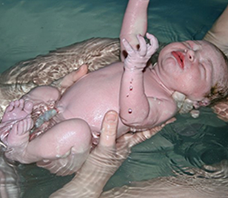Often called the midwife’s epidural, a tub full of warm water is a wonderful, natural way to relieve pain and tension. Just as you would soak in a hot bath after a long day to ease sore muscles and tension, so many women opt to use warm water to ease labor and/or delivery.
Warm water has several incredible benefits to a laboring woman. Water:
- Takes away gravity, making it very easy to move into comfortable positions – even flat on the tummy if the tub is large enough.
- Supports your body and muscles, especially the uterus and back.
- Regulates vital signs, decreasing higher blood pressures, heart rates, and respirations.
- Softens and relaxes the tissues of the perineum helping them to stretch more easily.
- Decreases stress hormones, including adrenaline, which slows or even stops labor.
- Facilitates relaxation. This is the most important benefit because relaxation:
- Increases endorphins (natural pain-inhibitors) and oxytocin (hormone necessary for contractions), which in turn….
- Speeds labor
- Decreases pain!
 The water seems to act as a protective “aura” around the woman, where she feels less vulnerable and more in control of herself. As the baby is being born, the mother can choose to deliver the infant herself, as the midwives kneel at the tub in case they are needed. It is usually very simple for the mother, after she has the last contraction that expels the baby, to reach down, take her baby in her arms and bring baby up out of the water and to her breast. It is also very easy for dad to help catch the baby if desired.
The water seems to act as a protective “aura” around the woman, where she feels less vulnerable and more in control of herself. As the baby is being born, the mother can choose to deliver the infant herself, as the midwives kneel at the tub in case they are needed. It is usually very simple for the mother, after she has the last contraction that expels the baby, to reach down, take her baby in her arms and bring baby up out of the water and to her breast. It is also very easy for dad to help catch the baby if desired.
Common Questions about Waterbirth
Why Water Birth for Baby?
Is Water Birth Safe?
How Can I have a Water Birth?
Why Water Birth for Baby?
Water birth is such a gentle way to enter the world! As the baby leaves her former home of warm amniotic fluid, she enters the warm water of the birth tub, where the sounds are muffled and the sights are dimmed, and she is gently lifted up to the surface just enough so that she can begin to breathe. Her body continues to stay warm and supported in the water. Water-born babies, once they are gently pulled up out of the water, tend to cry less, while still having good muscle tone and respirations, than babies born outside of water. Most babies love to float in the water and stretch out with mom’s help. This is an incredible bonding moment between mom and baby.
Is Waterbirth Safe?
Yes, water birth is very safe; in fact worldwide statistics show that water birth, without the use of drugs, is the safest way to be born. The concern of most parents is will their baby inhale water and drown? Babies have what is called a dive reflex, which causes them to swallow instead of inhale when water gets into their mouth or nose. They swallow and then hold their breath. Because they are still attached to the umbilical cord, they continue to receive all their needed oxygen through it, making it unnecessary to breathe up to several minutes after birth. However, we always gently but immediately bring the baby’s face out of the water after the birth to initiate breathing. When the baby’s face comes in contact with cool air, it is believed that this is one of the main things that stimulates them to breathe and most babies begin breathing within seconds of this.
How Can I have a Water Birth
There are a few circumstances that may disqualify one from having a water birth. This includes anything emergent, an extra long pushing phase, meconium stained amniotic fluid, and a history of hemorrhage.
All that is needed is a tub that is at least 12 inches deep that can be kept warm – 18 inches is preferable. We rent out portable tubs for homebirths if desired. The Birth Place has two beautiful birth rooms with birth tubs as well, if you choose a birthcenter birth. We use a special under-water Doppler to listen to the baby’s heart rate during labor without having to disrupt the mother. Some mothers choose to labor in the tub and then birth on the bed. Others choose to labor and deliver in the water. We encourage the mother to do whichever makes her feel the most comfortable. Salt may be added to tub to decrease bacteria in the water and essential oils can be dropped only in the portable tub (such as lavender, ylang-ylang, or rose for relaxation).
The portable tub is large enough for dad to get in, if desired. He can make it very comfortable for mom, by supporting her in the tub. Women can wear a bra, swimsuit top or t-shirt if modest. Most of our mothers feel most free and comfortable wearing nothing, which is fine also!
Once the baby is born, if there is no extra bleeding, you may stay in the tub for up to 20 minutes or so while waiting for the placenta to deliver. The placenta can usually be birthed easily into the water.